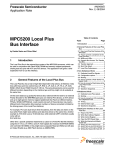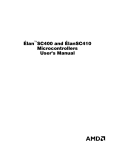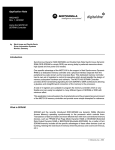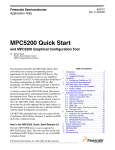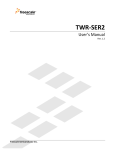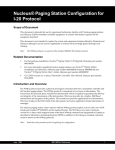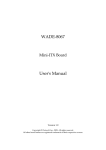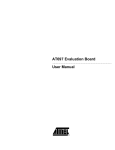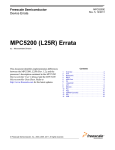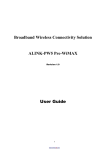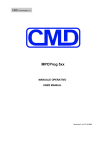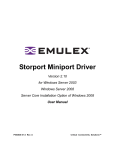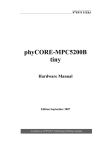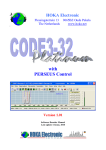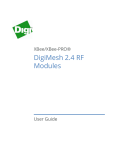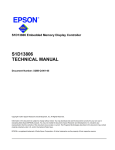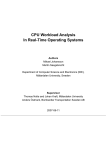Download Application Note
Transcript
Freescale Semiconductor Application Note AN2458 Rev. 3, 04/2005 MPC5200 Local Plus Bus Interface by: Davide Santo and Oliver Bibel 1 Introduction The Local Plus Bus is the external bus system of the MPC5200 processor, which can be used in conjunction with Flash ROM, SRAM and memory mapped peripherals sharing data bus pins with ATA and PCI devices. This application note gives a brief explanation how to use this interface with memory mapped peripherals like Flash or SRAM. This application note does not cover any workarounds required for potential bugs of the MPC5200 processor. Please refer to the latest Errata list of the MPC5200 available from the Freescale web page. 2 General Features of the Local Plus Bus The Local Plus Bus has a total of eight independent chip selects, 32 Address / Data lines (AD lines) and nine control lines (LP_R/W_b, LP_ALE_b, LP_TS_b, LP_ACK, BANK_SEL[1:0] and TSIZ[1:0] and LP_OE_b). The same physical pins can be used for © Freescale Semiconductor, Inc., 2005. All rights reserved. Table of Contents 1 2 3 4 5 Introduction . . . . . . . . . . . . . . . . . . . . . . . . . . . . . . 1 General Features of the Local Plus Bus . . . . . . . . 1 Non-Multiplexed Mode . . . . . . . . . . . . . . . . . . . . . 9 Multiplexed Mode . . . . . . . . . . . . . . . . . . . . . . . . 22 BestComm Interface to the Local Plus Bus . . . . 32 General Features of the Local Plus Bus different functions depending on the interface type and they might not all available at the same time. On the same data bus several PCI devices (if more than one external PCI device with bus master capabilities is intended to be used an external Priority Encoder for the single build in GNT/REQ pair needs to be added), an ATA device and up to eight generic memory mapped peripherals like Flash, FPGAs, SRAM, E2PROM, etc. could coexist and each of these devices may need a different kind of transaction. For example, PCI uses dual tenure (first the address, then the data are driven on the bus) while Flash might need address and data lines driven at the same time. Another example is ATA which uses a 16-bit wide bus, while external UART controllers usually come with an 8-bit wide bus. Other time a specific peripheral implements a subset of a PowerPC 60x-like interface using the LP_TS_b, LP_R/W_b and LP_ACK signals (for instance the EPSON-SEIKO LCD controller SD13806) or they might need a separate Read and Write bar with also an Output Enable (e.g. AMD Flash devices as AM29LV065). 2.1 New Local Plus Bus Features of the MPC5200 Two new operating modes called Large Flash and Most/Graphic have been implemented in the Local Plus interface. They both can be used to BOOT MPC5200 using normal off-the shelf ROM memory devices without the need for external glue logic. The Large Flash interface supports up to 64 Mbytes (it has 26 address lines A25-A0 and 16 bit data lines D16-D0, where the higher ordered number indicates always the Most Significant bit), while the Most/Graphic interface covers up to 16 Mbytes (24 Address by 32 Data bus width). Both have TSIZ signals and LP_OE_b directly available. The MPC5200 processor has been designed using the ‘same’ package (PBGA 272 pins) as its predecessor. Therefore the two newly introduced interfaces share now some pins with the PCI/ATA interface preventing them from being simultaneously used at any moment during MPC5200 operations (not only during BOOT). The basic rule is that PCI is mutually exclusive with the Large Flash or Most/Graphic (but not with the legacy modes of the Local Plus), while ATA can be used with all the legacy modes plus the Large Flash Interface but not with the MOST graphic one. At power on the PCI controller is in a reset state to avoid possible contention on the Local Plus Bus thus preventing a correct boot process from happening. The PCI controller is taken out of reset via a control bit (bit 16 of the GPIO Port Configuration Register located at MBAR + 0x0B00). ATA is a chip select controlled interface, then it will not interfere during Boot. It is important to recall that the MPC5200 ATA controller does NOT provide for a reset line to be connected to the SW_RESET (pin #1 of the standard 40 pin ATA connector); this line must be implemented via a GPIO. Two new Power On Reset Configuration Pins (large_flash_sel connected to ball K02 and most_graphic_sel connected to ball K01) allow the user to select one of the 2 modes for booting. Only one of the two new modes can be selected at the time; if both POR Configuration pins are set to a logic ‘1’ the LPC will not boot properly or as expected. If none of them is selected then one of the legacy booting mode, either not-muxed or muxed, is automatically used. MPC5200 Local Plus Bus Interface, Rev. 3 2 Freescale Semiconductor General Features of the Local Plus Bus As a second new feature for the MPC5200 processor there is the support for today most common burst flash (see as reference the Intel 28F160F3 or AMD29BL802C or ST Microelectronic M58BW016) to reduce the total booting time. Full Bursting is supported for Read only (no write) by the Local Plus controller on the Large Flash, Most/Graphic operating modes. If the bursting controlled device supports ‘Critical Double Word First (CDWF)’ wrapping order, then a complete ‘cache line’ (32 Words) can be read in at the time. When this is not the case, the Local Plus controller can downgrade an internal XLB request to a ‘cache word’ size (64 bits per beat). All of this happens dynamically in the LPC hardware: if an 8-byte XLB fetch happens (i.e.instruction fetch), then a 64 bit Burst will occur at the peripheral. If an XLB 32-byte cache line fetch happens, then a cache Line burst will occur at the peripheral. It is not possible to burst using an access less that the port size. Bursting mode (64 bit versus CDWF mode) must programmed via SW before first burst transaction can be performed. Up to three dead cycles can be inserted in a read (Not in a write access!) to better adapt to different peripheral’s hold time requirements. Dead cycles are at boot set to the maximum possible (3) and are programmed via SW. The dead cycles (when set to 0 or 1) can be ‘hidden’ by arbitration cycles and do not add to them. The Local Plus in the MPC5200 is also hooked to the internal DMA engine (BestComm) allowing data movement to be generated independently from CPU. The interface has been implemented by using a single FIFO (512 bytes deep), which means that the data movement can only happen in a single direction, TX or RX, at the time (i.e. only Half Duplex communication is possible). Last the Local Plus being shared among different controllers (PCI, ATA, LPC) is arbitrated by a dedicated arbiter which adds ‘Bus Parking’ as new feature in the MPC5200. ‘Bus Parking’ is not available for an external Master (such as an external PCI Initiator device). The Local Plus Bus interface, being so flexible, can be adjusted to meet all its different operating modes by means of software configuration and in some cases minimal external logic (in the multiplexed mode precisely). NOTE: Multiplexed versus Non-Multiplexed Mode The most important concept to understand are the Local Plus’ two main modes of operation: multiplexed mode and non-multiplexed mode (Bursting can happen ONLY in a non-multiplexed mode of the Local Plus). 2.2 How to connect a peripheral to the Local Plus Bus MPC5200 supports the PCI bus naming convention on the Local Plus Bus. This means that the byte ordering of the external pins conforms to the little endianess rule typical for PCI. Having a PowerPC core inside, the MPC5200’s internal registers, the internal memory and peripherals’ bus (XLB and IPBI bus) adhere instead to the big endian ordering rule. Please refer to the MPC5200 User Manual for more details about the XLBus and the IPBI. The swap is automatically done in the Local Plus module and it is completely transparent to the user. MPC5200 Local Plus Bus Interface, Rev. 3 Freescale Semiconductor 3 General Features of the Local Plus Bus 2.3 MSBs and LSBs To connect an external device to the Local Plus Bus a couple of simple rules can be used regardless of the mode the bus will use to control the device itself: • A lower bit number in the pin name indicates lower importance of the line in terms of the bit ordering (‘0’ is always the least significant bit). • MPC5200’s Local Plus Bus pins are called AD[31:0] where bit 31 is the most significant bit and bit 0 is the least significant bit. • PCI-mode: All 32 bits AD[31:0] are used. • ATA-mode: Data is connected to AD[15:0] and address to AD[18:16]. 2.4 Dynamic Bus Access: The Transfer Size Bits The Local Plus bus allows dynamic bus sizing in the terms that on any chip select a transaction of up to 128-bit data width (a Cache line) is allowed and performed transparently to the user. Dynamic Bus Access refers to any XLB transaction size that is different (larger or shorter) than the LPC data port size, thus forcing the LPC to dynamically break the transactions down into multiple LPC bus tenures in order to assemble/disassemble the XLB data transfer onto the LPC bus. As an example an “instruction fetch” beat (64 bit long) is supported by the Local Plus controller, which translates it into the correct number of external access either 2 for the Most/Graphic interface or 4 for the Large Flash. The Local Plus controller supports XLB cache-line bursting (32 byte long) assuming that the memory device also supports the Critical Double Word First ordering scheme. These modes of the Local Plus are software programmable; please refer to the PowerPC user manual (e.g. refer to “MPC603e & EC603e Risc Microprocessor User Manual”) and to the MPC5200 User Manual for further details. During a Local Plus access using either the legacy multiplexed or the Large Flash or the Most/Graphic mode Transfer Size bits and the address line A0 (LSB) and A1 are put on the bus to reflect the specified transaction similar to the usual dynamic bus access of PowerPC family microprocessors. Specifically in the Muxed Mode three Transfer Size bits TSIZ[0:2] are available (on AD[30:28] during the address tenure), where the most significant one TSIZ[0] is reserved for future use. On the Large Flash and Most graphic mode only TSIZ[1:2] have been pinned out. The meaning of the TSIZ[1:2] is in any case the same for the muxed mode and the Large Flash or Most graphic modes. 2.5 Transfer alignment To illustrate transfer alignments on the bus the following example assumes that the processor performs a transaction where a 32-bit word, e.g. 0x1234ABCD, is read in one 32-bit, two 16-bit or four 8-bit accesses, respectively. MPC5200 Local Plus Bus Interface, Rev. 3 4 Freescale Semiconductor General Features of the Local Plus Bus 2.5.1 Reading From a 32-Bit Port When reading from a 32-bit port dynamic bus sizing allows the transfer to take place in a single word access, in two half word accesses or in four consecutive byte accesses. The following tables show the position of the data byte lanes expected by the MPC5200 and the value of the TSIZ bits driven by the MPC5200. Please refer to Table 11 on page 9 or Table 13 on page 22 for the pins where the TSIZ signals will be available depending on the Local Plus mode selected. Note that in the following tables AD[31:24] is the most significant byte lane while AD[7:0] is the least significant byte lane and that A0 is the least significant bit of the address. Table 1. Single 32-bit access TSIZ1 TSIZ2 A1 A0 AD[31:24] AD[23:16] AD[15:8] AD[7:0] 0 0 0 0 0x12 0x34 0xAB 0xCD AD[15:8] AD[7:0] 0xAB 0XCD AD[15:8] AD[7:0] Table 2. Two 16-bit access TSIZ1 TSIZ2 A1 A0 AD[31:24] AD[23:16] 1 0 0 0 0x12 0x34 1 0 1 0 Table 3. Four 8-bit access 2.5.2 TSIZ1 TSIZ2 A1 A0 AD[31:24] 0 1 0 0 0x12 0 1 0 1 0 1 1 0 0 1 1 1 AD[23:16] 0x34 0xAB 0xCD Reading from a 16-bit port If reading from a 16-bit port, then either a 16-bit access or two 8-bit accesses are used. To configure the port size the Configuration Register of the used chip select must be written. Note that in a 16-bit chip select the valid data byte lanes are the upper two ones, i.e. AD[31:24] (MSB) and AD[23:16] (LSB). Table 4. Single 16-bit access TSIZ1 TSIZ2 A1 A0 AD[31:24] AD[23:16] 1 0 0 0 0x12 0x34 1 0 1 0 0xAB 0XCD AD[15:8] AD[7:0] MPC5200 Local Plus Bus Interface, Rev. 3 Freescale Semiconductor 5 General Features of the Local Plus Bus Table 5. Two 8-bit access 2.5.3 TSIZ1 TSIZ2 A1 A0 AD[31:24] 0 1 0 0 0x12 0 1 0 1 0 1 1 0 0 1 1 1 AD[23:16] AD[15:8] AD[7:0] 0x34 0xAB 0xCD Reading from a 8-bit port With data contents as before, now the chip select is configured as a single byte located on AD[31:24]. Therefore, only four consecutive accesses are used. It must be noted that this is transparent to the user. Table 6. Four 8-bit access 2.5.4 TSIZ1 TSIZ2 A1 A0 AD[31:24] 0 1 0 0 0x12 0 1 0 1 0x34 0 1 1 0 0xAB 0 1 1 1 0xCD AD[23:16] AD[15:8] AD[7:0] Write Transaction This example details a 32-bit write transaction. As before the value 0x1234ABCD is used to demonstrate a 32-bit, two 16-bit or four 8-bits write accesses of the MPC5200 to a peripheral. Table 7. Single 32-bit access TSIZ1 TSIZ2 A1 A0 AD[31:24] AD[23:16] AD[15:8] AD[7:0] 0 0 0 0 0x12 0x34 0xAB 0xCD AD[15:8] AD[7:0] 0xAB 0XCD Table 8. Two 16-bit access TSIZ1 TSIZ2 A1 A0 AD[31:24] AD[23:16] 1 0 0 0 0x12 0x34 1 0 1 0 0xAB 0XCD MPC5200 Local Plus Bus Interface, Rev. 3 6 Freescale Semiconductor General Features of the Local Plus Bus Table 9. Four 8-bit access 2.6 TSIZ1 TSIZ2 A1 A0 AD[31:24] 0 1 0 0 0x12 0 1 0 1 0x34 0 1 1 0 0xAB 0 1 1 1 0xCD AD[23:16] AD[15:8] AD[7:0] 0x34 0xAB 0xCD Boot Chip Select For booting the MPC5200 uses a special chip select called Chip Select Boot (CSBOOT). This signal is physically tied to the same ball as chip select 0 (CS0). CSBOOT and CS0 also share the configuration register located at offset 0x0300 from the module base address (MBAR). The only difference between the two ‘virtual’ chip selects (CSBOOT and CS0) lies in the fact that CSBOOT is enabled after reset (during boot) and CS0 must first be enabled by software before it can be used as a CS line. NOTE: Code Execution Code can be executed from any chip select (CSBOOT, CS0 through CS7). Also, the two virtual chip select have different mapping registers. CS0 start and stop virtual address values are mapped at MBAR+0x04 and MBAR+0x08, while CSBOOT is mapped at MBAR+0x4C and MBAR+0x50. It is essential to avoid to have both of them enabled (using the enabling control register at MBAR + 0x54) at the same time. 2.7 Local Plus Performance The Local Plus interface has been originally designed to be an easy-to-use interface not specifically focused on high speed performance. For this reason arbitration of the bus (there can be different masters on the Local Plus as the processor core, an external PCI master and different targets could be accessed such as ATA, PCI or an external memory mapped device) may be performed at every new access. This of course adds some overhead time, which should be taken into consideration when trying to evaluate the speed characteristics and performances of this interface. As already mentioned ‘Bus Parking’ is available but only for internal Masters (LP controller, PCI controller and ATA controller). This feature improves performances allowing a Master to have immediate access to the bus without having to re-arbitrate as long as no other requests are pending. NOTE: Local Plus Bus Reference Clock MPC5200 is using the PCI clock as the internal reference clock. As a result all clock counts are with respect to the PCI clock. All transitions are synchronized to the rising edge of the PCI clock. The Local Plus has a BestComm hook. Therefore Local Plus can directly transfer in a DMA fashion data from the target to BestComm’s FIFOs, thus increasing performance. The BestComm interface is a Half Duplex only designed on a 512 deep FIFO. Alarm and granularity level can be set via SW and any CS can MPC5200 Local Plus Bus Interface, Rev. 3 Freescale Semiconductor 7 Non-Multiplexed Mode be supported by the internal DMA engine. See <st-blue>Chapter 5, <st-blue><st-italic>BestComm Interface to the Local Plus Bus, for more details. XLB bus processing and arbitration cycles are removed from the Local Plus Controller transaction timing clock counts when the BestComm interface is used. 3 Non-Multiplexed Mode In non-multiplexed mode, the 32 physical AD pins of the MPC5200 are divided into two separate, non multiplexed groups, precisely the address and data partitions. This allows data and address to be driven at the same time on separate pins. Eight different configurations of address and data lines are supported. Table 10. Non-Multiplexed Address/Data Size Options Non Muxed Modes (address and data at the same time) Mode Name LegacyNonMuxed 8 LegacyNonMuxed 8 LegacyNonMuxed 8 LegacyNonMuxed 16 LegacyNonMuxed 16 Large Flash 16 Large Flash8 MOST / Graphics 32 Address Data TSIZE Size Size Bits 24 8 16 8 8 8 16 16 8 16 26 16 26 8 24 32 2 Total BANK Memory Size Memory Size Bits [Bytes] [MBytes] 16777216 16 65536 0,0625 256 0,000244141 65536 0,0625 256 0,000244141 67108864 64 64 67108864 16777216 16 Boot Option yes no no yes no yes yes yes Burst Support no no no no no yes yes yes ATA Support yes yes yes yes yes yes yes no PCI Support yes yes yes yes yes no no no For example a possible booting configuration uses 24 address and 8 data lines and is thus able to address 224 data bytes, or a total of 16 Mbytes. A second configuration uses 16 address and 16 data lines. Here, 215 address lines point at a half-word each for at a total of 64 kBytes. NOTE: Byte Addressing is used in all modes 16-Bit wide data connection to the peripheral: Any two ‘short’ addresses [16 bit data] are separated by an 0x02 address offset, which clearly indicates that A0 lines is never asserted, or used thus it shall not be connected to the device. The pin A[0] of the controlled device is usually connected to A[1] of the processor. 32-Bit wide data connection to the peripheral: Any two ‘word’ addresses [32 bit data] are separated by an 0x04 address offset, which clearly indicates that A[1:0] lines are never asserted, or used thus they shall not be connected to the device. The pins A[1:0] of the controlled device are usually connected to A[3:2] of the processor. The TSIZ[1:2] pins can sometimes be used in conjunction with A[1:0] to select which byte or short is actually used during the transfer and allow transfers smaller than the physical connection to the peripheral. In such case a direct connection from A[1:0] (processor) to A[1:0] (device) is possible or necessary. MPC5200 Local Plus Bus Interface, Rev. 3 8 Freescale Semiconductor Non-Multiplexed Mode The Non-Multiplexed Mode is able to interface gluelessly with memory mapped external devices like Flash ROM, E2PROM or SRAM. It is also faster than the multiplexed mode as it provides both data and address in a single tenure. The following table shows the Local Plus bus signals of the most important Non-muxed Modes. Table 11. Local Plus Signals of the most important Non-muxed Modes Non Muxed Modes (address and data at the same time) SignalName[MSB:LSB] Local Plus Bus Signal Functionality Dedending On Mode Configured Large Flash16 Read Large Flash16 Burst Enabled MPC5200 Signal Name LegacyNonMuxed8 LegacyNonMuxed16 Read / Write Read / Write Read / Write Read / Write LP_R/W_b LP_ALE_b Transfer Acknowledge Transfer Acknowledge Transfer Acknowledge Burst Advance LP_ACK_b LP_TS_b - - Transfer Start LP_OE_b CS[7:0] LP_AD[31:24] LP_AD[23:16] LP_AD[15:8] LP_AD[7:0] TSIZE_1 TEST_SEL_1 PCI_CLK PCI_PAR PCI_C/BE_0 PCI_C/BE_1 PCI_C/BE_2 PCI_C/BE_3 PCI_TRDY PCI_IRDY PCI_STOP PCI_DEVSEL PCI_FRAME PCI_SERR PCI_PERR PCI_IDSEL PCI_REQ PCI_GNT PCI_RESET ATA_DRQ ATA_DACK ATA_IOR ATA_IOW ATA_IOCHDRY ATA_INTRQ ATA_ISOLATION Output Enable CS[7:0] D[7:0] A[23:16] A[15:8] A[7:0] PCI_CLK - Output Enable CS[7:0] D[15:8] D[7:0] A[15:8] A[7:0] PCI_CLK - Output Enable CS[7:0] D[15:8] D[7:0] A[15:8] A[7:0] PCI_CLK A16 A17 A18 A19 A20 A21 A22 A23 A24 A25 - 3.1 3.1.1 Start Address for Burst Output Enable CS[7:0] D[15:8] D[7:0] A[15:8] A[7:0] PCI_CLK A16 A17 A18 A19 A20 A21 A22 A23 A24 A25 - MOST / Graphics MOST / Graphics Read Burst Enabled 32 32 Read / Write Read / Write A23 A23 Transfer Burst Advance Acknowledge Transfer Start Start Address for Burst Output Enable Output Enable CS[7:0] CS[7:0] D[31:24] D[31:24] D[23:16] D[23:16] D[15:8] D[15:8] D[7:0] D[7:0] TSIZE1 TSIZE1 TSIZE2 TSIZE2 PCI_CLK PCI_CLK A0 A0 A1 A1 A2 A2 A3 A3 A4 A4 A5 A5 A6 A6 A7 A7 A8 A8 A9 A9 A10 A10 A11 A11 A12 A12 A13 A13 A14 A14 A15 A15 A16 A16 A17 A17 A18 A18 A19 A19 A20 A20 A21 A21 A22 A22 Special Dedicated Local Plus Signals Transfer Acknowledge (LP_ACK_b) The use of LP_ACK_b for termination is software programmable. The LP_ACK_b, when input, can only reduce the maximum programmed duration of the chip select transaction but never prolong it. The same pin can be used as an output in the Most/Graphics and Large Flash interface indicating the burst advance of a burst access. MPC5200 Local Plus Bus Interface, Rev. 3 Freescale Semiconductor 9 Non-Multiplexed Mode NOTE: Acknowledge active during boot The LP_ACK_b functionality is enabled during boot and therefore requires a pull up resistor to disable the acknowledge input in case the peripheral from which the boot code is fetched does not support the acknowledge feature. 3.1.2 Address Latch Enable (LP_ALE_b) This signal serves as the additional address line A23 when MOST/Graphics mode is selected. 3.1.3 Transfer Start (LP_TS_b) This pin can be used as an output in the Most/Graphics mode (burst mode only) and Large Flash mode (burst mode only) indicating a valid start address for the next burst transfer. 3.2 3.2.1 Configuration options Wait States The numbers for read and write wait states can be set independently. The wait states are counted in PCI clock cycles. 3.2.2 Dead Cycles Dead cycles after a read access can be inserted (up to three as chosen by the user via software) to provide for proper peripheral hold time. Some dead cycles might be hidden by arbitration. In either case the data and control signals will be maintained one clock cycle beyond CSx negation to assure hold time. 3.3 Booting At boot by default (via the Hardware Reset Word) the wait states inserted can be either 4 PCI clock cycles or 48 PCI clock cycles. This value can be changed by software to anything from 0 to 127 (or even more when a prescaler is used) once the boot process has successfully started. Normally a slow device such as Flash ROM memory may need some waits states and therefore at the very boot it might be necessary to start the MPC5200 with the longest wait state default (48 PCI Clocks = 727 ns at the maximum allowed Local Plus speed of 66 MHz). 3.4 How to connect a Flash device in a legacy mode This example assumes the use of a byte wide Flash device with an address space of 8 MBytes. In this case the 24-address/8-bit data non-multiplexed mode can be used. The AD pins are split in two groups the following way: AD[23:0] are used as address lines A[23:0] and AD[31:24] are used as data lines D[7:0]. MPC5200 Local Plus Bus Interface, Rev. 3 10 Freescale Semiconductor Non-Multiplexed Mode With this convention the Address and the Data bus can be directly connected to the device. In fact, A0 is the least significant bit of the address section of the Local Plus interface while D[0] (connected to AD[24] on the processor) is the least significant bit of the data byte lane. R10 R11 R12 R13 R14 R15 R16 R17 R18 R19 R20 10K 10K 10K 10K 10K U2 U1A Y 19 Y 18 W18 Y 17 W17 V17 Y 16 PCI_GNT PCI_RESET PCI_CLOCK PCI_IDSEL PCI_REQ PCI_C/BE_3 PCI_C/BE_2 PCI_C/BE_1 PCI_C/BE_0 PCI_FRAME PCI_TRDY PCI_STOP PCI_IRDY PCI_PAR PCI_DEVSEL PCI_PERR PCI_SERR R21 R22 R4 R2 T1 U2 U1 Y2 W6 Y8 W10 V5 W5 V6 Y6 V7 W7 Y7 W8 ATA_INTRQ ATA_DACK ATA_IOCHDRY ATA_IOR ATA_IOW ATA_DRQ ATA_ISOLATION CS0 CS1 CS2 CS3 CS4 CS5 LP_OE LP_TS LP_ACK LP_ALE LP_R/W AD0 AD1 AD2 AD3 AD4 AD5 AD6 AD7 AD8 AD9 AD10 AD11 AD12 AD13 AD14 AD15 10K 5K6 AD16 AD17 AD18 AD19 AD20 AD21 AD22 AD23 AD24 AD25 AD26 AD27 AD28 AD29 AD30 AD31 IRQ_0 IRQ_1 IRQ_2 IRQ_3 W14 Y 14 V15 W15 Y 15 V16 H2 D8 Y 13 U14 V14 W16 J2 C5 V13 W13 V12 Y 12 V11 W12 U11 Y 11 G2 F2 E2 C2 D2 F3 E3 C3 W11 V10 Y 10 V9 Y9 V8 W9 U8 D6 C6 H6 E6 F6 D7 C7 E7 W4 Y5 V4 Y4 V2 Y3 V3 W3 F7 G7 D3 G6 J7 K4 E5 U3 W2 T2 Y1 T3 W1 R3 V1 G3 K3 G4 H4 K5 G5 J6 K6 P3 P1 P2 R1 C4 CE OE WE A0 A1 A2 A3 A4 A5 A6 A7 A8 A9 A10 A11 A12 A13 A14 A15 A16 A17 A18 A19 A20 A21 A22 8MByte Flash, AM29LV065D R9 1K 10K 10K 10K 10K 10K 10K R1 R2 R3 R4 R5 R6 R7 R8 3.3V 5K6 5K6 5K6 5K6 5K6 5K6 5K6 5K6 3.3V DQ0 DQ1 DQ2 DQ3 DQ4 DQ5 DQ6 DQ7 RY /BY AM29LV065D MPC5200 Figure 1. Legacy Non-Multiplexed Mode MPC5200 Local Plus Bus Interface, Rev. 3 Freescale Semiconductor 11 Non-Multiplexed Mode 3.5 How to connect a Flash device in the Large Flash Mode This example assumes the use of a synchronous 16 Bit wide Flash device with an address space of 1 MByte that supports burst reads. Figure 2 shows how the Local Plus pins have to be connected to the flash device. It should be noted that also some PCI signals are used to extend the address range of the Local Plus Bus during Local Plus transfers. A maximum of 26 address lines (A[25:0]) is available in the Large Flash mode. In this example only A[19:1] are required to cover the whole address range of the flash device connected. A[0] is the LSB of the address section of the Local Plus interface and D[0] is the LSB of the data byte lane. MPC5200 Local Plus Bus Interface, Rev. 3 12 Freescale Semiconductor Non-Multiplexed Mode R4 R2 U2 U1 Y2 V5 W5 V6 Y6 PCI_GNT PCI_RESET PCI_IDSEL PCI_REQ PCI_C/BE_3 PCI_FRAME PCI_TRDY PCI_STOP PCI_IRDY PCI_DEVSEL PCI_PERR PCI_SERR 10K 5K6 R22 R23 W7 Y7 W8 ATA_INTRQ ATA_DACK ATA_IOCHDRY ATA_IOR ATA_IOW ATA_DRQ ATA_ISOLATION LP_OE LP_TS LP_ACK LP_ALE LP_R/W AD0 AD1 AD2 AD3 AD4 AD5 AD6 AD7 AD8 AD9 AD10 AD11 AD12 AD13 AD14 AD15 PCI_PAR PCI_C/BE_0 PCI_C/BE_1 PCI_C/BE_2 AD16 AD17 AD18 AD19 AD20 AD21 AD22 AD23 AD24 AD25 AD26 AD27 AD28 AD29 AD30 AD31 IRQ_0 IRQ_1 IRQ_2 IRQ_3 R16 R17 R18 R19 R20 R21 10K 10K 10K 10K 10K 10K W14 Y 14 V15 W15 Y 15 V16 T1 D8 Y 13 U14 V14 W16 14 27 17 56 28 1 V13 W13 V12 Y 12 V11 W12 U11 Y 11 W11 13 12 11 10 9 8 7 6 V10 Y 10 V9 Y9 V8 W9 U8 V7 W10 Y8 W6 52 51 50 49 48 47 46 45 44 5 4 W4 Y5 V4 Y4 V2 Y3 V3 W3 18 20 22 24 33 35 37 39 U3 W2 T2 Y1 T3 W1 R3 V1 19 21 23 25 34 36 38 40 P3 P1 P2 R1 3 30 U2 CE# CLK OE# LBA# BAA# WE# A0 A1 A2 A3 A4 A5 A6 A7 A8 A9 A10 A11 A12 A13 A14 A15 A16 A17 A18 DQ0 DQ1 DQ2 DQ3 DQ4 DQ5 DQ6 DQ7 1MByte Burst Flash, AM29BL802C Y 19 Y 18 W18 Y 17 W17 V17 Y 16 CS0 CS1 CS2 CS3 CS4 CS5 PCI_CLOCK R10 R11 R12 R13 R14 R15 R9 1K U1A 10K 10K 10K 10K 10K 10K R1 R2 R3 R4 R5 R6 R7 R8 3.3V 5K6 5K6 5K6 5K6 5K6 5K6 5K6 5K6 3.3V DQ8 DQ9 DQ10 DQ11 DQ12 DQ13 DQ14 DQ15 RY /BY# IND# AM29BL802C MPC5200 Figure 2. Large Flash Mode 3.6 Timing To calculate how many clock cycles are involved in a Local Plus transaction the following data will be useful. For detailed values, like data and address set up and hold times, please refer to the MPC5200 Hardware Specification and the MPC5200 User Manual. MPC5200 Local Plus Bus Interface, Rev. 3 Freescale Semiconductor 13 Non-Multiplexed Mode The number of clock cycles given below will be per data beat, which is based on the port size (it could be 8-bit or 16-bit or 32-bit). The reference clock is the PCI clock. These numbers provide the best case timing, where it is assumed that the PCI arbiter is parked on the Local Plus controller, there is no other traffic on the internal Bus (XLB), and pipelining of the XLB is enabled. The XLB, for future reference, is the processor core’s bus (PPC 60X Local Bus). Again the Wait states must be computed in terms of PCI clock cycles. XLB pipeline can be turned on/off via SW control (the control register belongs to the XLB Arbiter register group). Pipelining refers to the possibility to start internally on the XLB bus a second address tenure while the data tenure corresponding to the previous address has not yet terminated (either with a TA or a TEA). It might increases performances depending on the application. With Dynamic Bus Sizing is important to remember that when a wider piece of data is decomposed in smaller chunks to adapt to the peripheral size no additional overhead is added. Nonetheless any time a new data (32 or 64 bit long) is to be read/written from the core a ‘turnaround’ overhead clock is needed. This is calculated by the formula: Overhead Clock = 4 x PCI/XLB clock ratio. Eqn. 1 Last is to note that while a normal PowerPC data or instruction can be maximum be 32-bit wide, an instruction fetch has always a size of 64 bit (to make full usage of the internal instruction pipeline).Write Access: 3.6.1 • • • • • • Write Access 1 Setup 1 CS assertion W = number of waits states (0 to 127) 4 * pci/xlb clock ratio 1 1 LPC processing 2 4 * pci/xlb clock ratio 3 For an internal clock ratio of the XLB:IPBI:PCI = 4:2:1, a minimum of 4 pci clocks+W per bus tenure is needed for back-to-back writes. 3.6.2 • • • • • Read Access (non burst) 1 Setup 1 CS assertion W = number of waits states (0 to 127) D = programmable dead cycles (0 to 3) to allow peripheral time to 3-state bus after read 1 LPC processing (this may be masked by dead cycles if set to 1 or greater) 1. Do not add this cycle if the transaction is a dynamic LPC bus tenure. 2. Assumes the PCI arbiter is parked on the LPC, else this number is dependent upon Local Plus Bus traffic. 3. Add these cycle(s) to the count if XLB pipelining is turned off. MPC5200 Local Plus Bus Interface, Rev. 3 14 Freescale Semiconductor Non-Multiplexed Mode • • • 4 * pci/xlb clock ratio 1 1 LPC processing 2 4 * pci/xlb clock ratio 3 For an internal clock ratio of the XLB:IPBI:PCI = 4:2:1, a minimum of 5 PCI clocks+W+D per bus tenure is needed for back-to-back reads. 3.7 Waveform Snapshots The following pages contain snapshots of simulation waveforms for the following Local Plus port configurations: • Non-muxed 32-bit XLB read transaction to 16-bit address and 16-bit data port, resulting in dynamic Local Plus Controller accesses. Wait States=14, Dead Cycles=0. • Non-muxed 32-bit XLB write transaction to 16-bit address and 16-bit data port, resulting in dynamic Local Plus Controller accesses. Wait States=4, Dead Cycles=0. • Non-muxed 16-bit read transaction to 26-bit address and 16-bit data port, Wait States=5, Dead Cycles=0 • Non-muxed 16-bit write transaction to 26-bit address and 16-bit data port, Wait States=5, Dead Cycles=0 • Non-muxed 16-bit short burst read transaction to 26-bit address and 16-bit data port, Wait States=5, Dead Cycles=0 The simulations were run under the following conditions allowing for maximum performance on the Local Plus Bus: • Clock ratio as indicated in the figures. E.g. clock ratio = 4:2:1 (133MHz, 66MHz, 33MHz) • No other XLB traffic is present so XLB arbitration is dedicated to Zeppo core read/write access to/from the Local Plus Controller. • No other Local Plus Bus traffic is present so the PCI arbiter remains parked on the Local Plus Controller. These simulated conditions are characteristic of the conditions that would exist during boot operations, where pipelined read-read and read-write XLB transactions are not pipelined. 3.7.1 32 bit Read Access to an 16 bit Address and Data Port Wait State = 14, Dead Cycle = 0 Eqn. 2 This transaction shows a back-to-back LPC read access. The visible LPC transactions correspond to the first two XLB bus tenures. The second XLB address/data bus tenure is pipelined with respect to the first address/data bus tenure. As a result, XLB arbitration cycles do not impact the LPC as it goes from a write 1. Do not add this cycle if the transaction is a dynamic LPC bus tenure. 2. Assumes the PCI arbiter is parked on the LPC, else this number is dependent upon Local Plus Bus traffic. 3. Add these cycle(s) to the count if XLB pipelining is turned off. MPC5200 Local Plus Bus Interface, Rev. 3 Freescale Semiconductor 15 16 * * 42,681.6 3FF0026 FFFF 2728 42,000 Cursor1 = 41,393.664 ns Cursor2 = 42,681.6 41,393.664 Group: LocalPLUS xlb_clk = 1 ipg_clk = 1 pad_pci_clock = 1 Address% = ’h 3FF002 3* 3FF0024 Data%[31:16] = ’h 23 2* FFFF 2526 pad_csb_4 = 0 pad_lp_ts_b = 1 pad_lp_ack_b = 1 pad_lp_oe_b = 0 pad_lp_rwb = 1 pad_lp_ale_b = 1 MPC5200: 16+16 Not Muxed Mode: Dynamic Access (32 bit READ) D.SANTO Local Plus (XLB:IP:PCI=4:2:1) 14 Wait States PCI @ 33 MHz Non-Multiplexed Mode to a read transaction. There is a XLB clock cycle necessary for the XLB data bus tenure to complete and start the next tenure. Figure 3. Dynamic Bus Size Read, 14 Wait States, 0 DC MPC5200 Local Plus Bus Interface, Rev. 3 Freescale Semiconductor Non-Multiplexed Mode 3.7.2 32 bit Write Access to an 16 bit Address and Data Port ** ** 3FF0026 2728 34,053.068 ns 32,893.017 Group: LocalPLUS xlb_clk = 0 ipg_clk = 1 pad_pci_clock = 1 Address% = ’h 3FF002 * 3FF0024 Data%[31:16] = ’h 23 * 2526 pad_csb_4 = 1 pad_lp_ts_b = 1 pad_lp_ack_b = 1 pad_lp_oe_b = 1 pad_lp_rwb = 0 pad_lp_ale_b = 1 Cursor1 = 32,893.017 ns Cursor2 = 34,053.068 ns MPC5200: 16+16 Not Muxed Mode: Dynamic Access (32 bit WRITE) D.SANTO Local Plus (XLB:IP:PCI=4:2:1) 14 Wait States PCI @ 33 MHz Wait States = 14, Dead Cycles = 0.This waveform shows a dynamic bus sizing accesses performed by the LPC. Notice that there is no XLB related PCI clock penalties as the LPC collects the data necessary to complete the XLB data tenure; however, the XLB data tenure now consumes 2 LPC transactions to obtain the necessary data to complete its tenure. Figure 4. Dynamic Bus Size Write, 14 Wait States, 0 DC MPC5200 Local Plus Bus Interface, Rev. 3 Freescale Semiconductor 17 18 3FF0* 3* 5* FFFF 0* 1,792,265.333 ns Cursor1 = 1,792,162.944 ns Cursor2 = 1,792,192.896 ns 1,791,908.12 Group: LocalPLUS ipg_clk = 1 pad_pci_clock = 0 Address% = ’h 0100166 3FF* 0100166 Data%[31:16] = ’h 5959 0000 FFFF pad_csb_4 = 0 pad_lp_ts_b = 1 pad_lp_ack_b = 1 pad_lp_oe_b = 0 pad_lp_rwb = 1 pad_lp_ale_b = 1 MPC5200: Large Flash I/F: Single Read 3.7.3 D.SANTO Local Plus (XLB:IP:PCI=4:4:1) 5 Wait States PCI @ 33 MHz Non-Multiplexed Mode Large Flash Read Access Figure 5. Large Flash Read Access MPC5200 Local Plus Bus Interface, Rev. 3 Freescale Semiconductor Freescale Semiconductor 1,498,886.727 3F* 010* 00* 0E0E 1,499,247.533 ns Cursor1 = 1,499,187.456 ns Cursor2 = 1,499,217.408 ns Group: LocalPLUS ipg_clk = 1 pad_pci_clock = 1 Address% = ’h 3FF0000 3F* 0100036 Data%[31:16] = ’h 0000 00* 0DAA pad_csb_4 = 1 pad_lp_ts_b = 1 pad_lp_ack_b = 1 pad_lp_oe_b = 1 pad_lp_rwb = 0 pad_lp_ale_b = 1 MPC5200: Large Flash I/F: Write 3.7.4 D.SANTO Local Plus (XLB:IP:PCI=4:4:1) 5 Wait States PCI @ 33 MHz Non-Multiplexed Mode Large Flash Write Access Figure 6. Large Flash Write Access MPC5200 Local Plus Bus Interface, Rev. 3 19 20 3FF* 3F* 01* * * * * FFFF 00* FF* 1,587,367.328 ns ursor1 = 1,587,201.408 ns Cursor2 = 1,587,231.36 ns 1,586,871.936 Group: LocalPLUS ipg_clk = 1 pad_pci_clock = 0 Address% = ’h 01000A8 * 01000A8 Data%[31:16] = ’h 2BAA * FFFF pad_csb_4 = 0 pad_lp_ts_b = 1 pad_lp_ack_b = 0 pad_lp_oe_b = 0 pad_lp_rwb = 1 pad_lp_ale_b = 1 MPC5200: Large Flash I/F: Burst Read 3.7.5 D.SANTO Local Plus (XLB:IP:PCI=4:4:1) 5 Wait States PCI @ 33 MHz Non-Multiplexed Mode Large Flash Short Burst Read Access Figure 7. Large Flash Short Burst Read MPC5200 Local Plus Bus Interface, Rev. 3 Freescale Semiconductor Multiplexed Mode 4 Multiplexed Mode Opposed to the previous mode, the multiplexed mode implements the address and data lines multiplexed on the same physical pins using dual tenure (or time multiplexing). First, the address is driven on the shared address/data bus and LP_ALE_b is asserted. Then the data is either written or read during the assertion of chip select. Table 12. Multiplexed Address/Data Size Options Muxed Modes (first address tenure followed by the data tenure) LegacyMuxed 8 LegacyMuxed 8 LegacyMuxed 8 LegacyMuxed 8 LegacyMuxed 16 LegacyMuxed 16 LegacyMuxed 16 LegacyMuxed 16 LegacyMuxed 32 LegacyMuxed 32 LegacyMuxed 32 LegacyMuxed 32 Address Data TSIZE Size Size Bits 25 8 3 24 8 3 16 8 3 8 8 3 25 16 3 24 16 3 16 16 3 8 16 3 25 32 3 24 32 3 16 32 3 8 32 3 Memory Size Total Memory Size BANK per Bank [MBytes] Bits [Bytes] 2 33554432 128 2 16777216 64 2 65536 0,25 2 256 0,000976563 2 33554432 128 2 16777216 64 2 65536 0,25 2 256 0,000976563 2 33554432 128 2 16777216 64 2 65536 0,25 2 256 0,000976563 Boot Option no no no no yes no no no yes no no no Burst Support no no no no no no no no no no no no This approach is slower in comparison to the not-multiplexed mode as it multiplexes the bus functions in time. At least two PCI clocks more than in the non-multiplexed case are needed for each bus access. However, the multiplexed mode has the advantage of a bigger address space (up to 128 MBytes divided in 4 Banks). It also always needs external logic to latch the address in case this function is not provided by the peripheral. The latch gate must be active low, meaning the latch is transparent when its gating signal is kept asserted to a logic low value. NOTE: Address Latch Enable Attention must be paid to the fact that the LP_ALE_b signals deasserts at the same time as the CSx_b will assert (see MPC5200 Hardware Specification for more details about the Local Plus timing). A board trace delay then might cause the LP_ALE_b to deassert ‘later’ than the CS falling edge, thus causing Data to be latched instead of an Address. To avoid this problem a register (driven by the PCI_CLK, with LP_ALE_b gating the clock itself) can be used. Please refer to the latest Errata sheet of the MPC5200 regarding limitations of the LP_ALE_b signal implementation and its workarounds. The following table shows the Local Plus bus signals available in the Muxed Mode. MPC5200 Local Plus Bus Interface, Rev. 3 Freescale Semiconductor 21 Multiplexed Mode Table 13. LocalPlus Signals in Muxed Mode Muxed Modes (first address tenure followed by the data tenure) SignalName[MSB:LSB] Local Plus Bus Signal Functionality Dedending On Mode Configured MPC5200 Signal Name LP_R/W_b LP_ALE_b LegacyMuxed 8 LegacyMuxed 16 LegacyMuxed 32 Address Phase Data Phase Address Phase Data Phase Address Phase Data Phase Read / Write Read / Write Read / Write Read / Write Read / Write Read / Write Address Latch Enable Address Latch Enable Address Latch Enable Address Latch Enable Address Latch Enable Address Latch Enable LP_ACK Transfer Acknowledge Transfer Acknowledge Transfer Acknowledge Transfer Acknowledge Transfer Acknowledge Transfer Acknowledge LP_TS_b LP_OE_b CS[7:0] LP_AD[31] LP_AD[30] LP_AD[29] LP_AD[28] LP_AD[27] LP_AD[26] LP_AD[25] LP_AD[24] LP_AD[23] LP_AD[22] LP_AD[21] LP_AD[20] LP_AD[19] LP_AD[18] LP_AD[17] LP_AD[16] LP_AD[15] LP_AD[14] LP_AD[13] LP_AD[12] LP_AD[11] LP_AD[10] LP_AD[9] LP_AD[8] LP_AD[7] LP_AD[6] LP_AD[5] LP_AD[4] LP_AD[3] LP_AD[2] LP_AD[1] LP_AD[0] PCI_CLK 4.1 Transfer Start Output Enable CS[7:0] 0 TSIZE0 TSIZE1 TSIZE2 0 Bank Select Bit 1 Bank Select Bit 0 A24 A23 A22 A21 A20 A19 A18 A17 A16 A15 A14 A13 A12 A11 A10 A9 A8 A7 A6 A5 A4 A3 A2 A1 A0 PCI_CLK Transfer Start Output Enable CS[7:0] D7 D6 D5 D4 D3 D2 D1 D0 0 0 0 0 0 0 0 0 0 0 0 0 0 0 0 0 0 0 0 0 0 0 0 0 PCI_CLK Transfer Start Output Enable CS[7:0] 0 TSIZE0 TSIZE1 TSIZE2 0 Bank Select Bit 1 Bank Select Bit 0 A24 A23 A22 A21 A20 A19 A18 A17 A16 A15 A14 A13 A12 A11 A10 A9 A8 A7 A6 A5 A4 A3 A2 A1 A0 PCI_CLK Transfer Start Output Enable CS[7:0] D15 D14 D13 D12 D11 D10 D9 D8 D7 D6 D5 D4 D3 D2 D1 D0 0 0 0 0 0 0 0 0 0 0 0 0 0 0 0 0 PCI_CLK Transfer Start Output Enable CS[7:0] 0 TSIZE0 TSIZE1 TSIZE2 0 Bank Select Bit 1 Bank Select Bit 0 A24 A23 A22 A21 A20 A19 A18 A17 A16 A15 A14 A13 A12 A11 A10 A9 A8 A7 A6 A5 A4 A3 A2 A1 A0 PCI_CLK Transfer Start Output Enable CS[7:0] D31 D30 D29 D28 D27 D26 D25 D24 D23 D22 D21 D20 D19 D18 D17 D16 D15 D14 D13 D12 D11 D10 D9 D8 D7 D6 D5 D4 D3 D2 D1 D0 PCI_CLK Special Dedicated Local Plus signals NOTE: Bursting Bursting is not available in any of the Muxed Modes. 4.1.1 Transfer Acknowledge (LP_ACK_b) The use of LP_ACK_b for termination is software programmable. The LP_ACK_b, when input, can only reduce the maximum programmed duration of the chip select transaction but never prolong it. The same pin can be used as an output in the Most/Graphics and Large Flash interface indicating the burst advance of a burst access. MPC5200 Local Plus Bus Interface, Rev. 3 22 Freescale Semiconductor Multiplexed Mode NOTE: Acknowledge active during boot The LP_ACK_b functionality is enabled during boot and therefore requires a pull up resistor to disable the acknowledge input in case the peripheral from which the boot code is fetched does not support the acknowledge feature. 4.1.2 Address Latch Enable (LP_ALE_b) This signal serves as the a control signal for an external address latch in all muxed modes. Please note that there is no hold time left between the release of the LP_ALE_b signal an the assertion of the CS signal. This might impact some peripherals and must be carefully taken into consideration when designing an external address register. 4.1.3 Transfer Start (LP_TS_b) This signal is driven low during the first LP clock (the Local Plus bus is based on the PCI clock), when CS has been asserted to indicate the data phase of the transfer. 4.1.4 Transfer Size (TSIZ[0:2]) The multiplexed mode also provides the three Transfer Size bits (TSIZ[0:2]). They are available on AD[30:28] during the address phase of a transfer and are used to signal the size of the current transfer. NOTE: TSIZ Naming Convention AD[30] represents TSIZ[0] and it is reserved for future use. This bit is driven to ‘0’ when a 8 bit or 16 bit transaction is performed and to ‘1’ if a 32-bit transaction is executed. AD[29] represents TSIZ[1] and AD[28] represents TSIZ[2] during the address phase. In the Multiplexed Mode the data bus width can be either 8, 16 or 32. The boot modes are limited to 16 or 32 bit data width. 4.2 Booting At boot 8-bit wide multiplexed mode configuration is not supported. Only 16-bit or 32-bit wide data bus configurations are supported. Normally a slow device such as Flash ROM memory may need some waits states and therefore at the very boot it might be necessary to start the MPC5200 with the longest wait state default (48 PCI = 727 ns at maximum allowed PCI speed of 66 MHz). 4.3 Connecting an LCD Controller This example shows how a typical LCD controller, the SD 13806 by Epson-Seiko, can be connected to the Local Plus Bus in the Muxed Mode. This peripheral has 21 address lines and 16 separate data lines. It also implements an E-Bus-like interface which makes use of the Transfer Size bits as the control registers are MPC5200 Local Plus Bus Interface, Rev. 3 Freescale Semiconductor 23 Multiplexed Mode 8-bit wide while graphic data is 16-bits, the Transfer Start (LP_TS_b), Acknowledge (LP_ACK_b) and LP_R/W_b signals. R10 R11 R12 R13 R14 R15 R16 10K U2 U1A U2 U1 Y2 W6 Y8 W10 V5 W5 V6 Y6 V7 W7 Y7 W8 PCI_GNT PCI_RESET PCI_IDSEL PCI_REQ PCI_C/BE_3 PCI_C/BE_2 PCI_C/BE_1 PCI_C/BE_0 PCI_FRAME PCI_TRDY PCI_STOP PCI_IRDY PCI_PAR PCI_DEVSEL PCI_PERR PCI_SERR LP_OE LP_TS LP_ACK LP_ALE LP_R/W PCI_CLOCK AD0 AD1 AD2 AD3 AD4 AD5 AD6 AD7 R17 R18 BSB RD/WR M/REG D8 Y13 U14 V14 W16 T1 V13 W13 V12 Y12 V11 W12 U11 Y11 RD WE0 U3 U4 E CP D0 D1 D2 D3 D4 D5 D6 D7 Q0 Q1 Q2 Q3 Q4 Q5 Q6 Q7 A0 A1 A2 A3 A4 A5 A6 A7 Q0 Q1 Q2 Q3 Q4 Q5 Q6 Q7 A8 A9 A10 A11 A12 A13 A14 A15 Q0 Q1 Q2 Q3 Q4 Q5 Q6 Q7 A16 A17 A18 A19 A20 U5 E CP AD8 AD9 AD10 AD11 AD12 AD13 AD14 AD15 10K 5K6 CS BUSCLK 74LVC377 R4 R2 ATA_INTRQ ATA_DACK ATA_IOCHDRY ATA_IOR ATA_IOW ATA_DRQ ATA_ISOLATION W14 Y14 V15 W15 Y15 V16 W11 V10 Y10 V9 Y9 V8 W9 U8 D0 D1 D2 D3 D4 D5 D6 D7 74LVC377 Y19 Y18 W18 Y17 W17 V17 Y16 CS0 CS1 CS2 CS3 CS4 CS5 LCD CONTROLLER, S1D13806 R9 1K 10K 10K 10K 10K 10K 10K R1 R2 R3 R4 R5 R6 R7 R8 3.3V 5K6 5K6 5K6 5K6 5K6 5K6 5K6 5K6 3.3V U6 AD24 AD25 AD26 AD27 AD28 AD29 AD30 AD31 W4 Y5 V4 Y4 V2 Y3 V3 W3 D0 D1 D2 D3 D4 D5 D6 D7 74LVC377 E CP AD16 AD17 AD18 AD19 AD20 AD21 AD22 AD23 U3 W2 T2 Y1 T3 W1 R3 V1 MPC5200 D0 D1 D2 D3 D4 D5 D6 D7 D8 D9 D10 D11 D12 D13 D14 D15 S1D13806 Figure 8. LCD Controller in 16-Bit Local Plus Multiplexed Mode It is self evident that a legacy non-multiplexed mode is not viable as there would be either not enough address line (16 data lines +16 address lines) or not enough data lines (24 data lines + 8 address lines). In this case either an external logic is required to latch the address during the address tenure or the Large Flash interface could be used (which then would not allow the usage of PCI on the same design). The external registers will also store the TSIZ bits (on AD[28] the least significant TSIZ bit and on AD[29] the most significant TSIZ bit) for the legacy mode. For the Large Flash and Most Graphics interfaces, these bits are directly available from two separated pins. MPC5200 Local Plus Bus Interface, Rev. 3 24 Freescale Semiconductor Multiplexed Mode To connect the device properly the latched address lines A[20:0] must directly be connected to the A[20:0] pins of the slave device, while for the data part the lines AD[31:16] will be connected to the pins named D[15:0] on the LCD controller (AD[16] again being the least significant bit). 4.4 Timing Please refer to the Hardware Specification of the MPC5200 for detailed timing values of the Local Plus interface. This chapter shows how to calculate the number of clock cycles one access in the muxed mode would take. Note that during data tenure, the decision between data being driven or the AD bit being tri-stated is dependent on whether the transaction is a Read or a Write and what the programmed data size is. Unused bits in the data tenure (i.e. those in excess of the programmed data size) will be driven to zero by the Local Plus Bus controller as a precaution to avoid floating bus condition. The maximum address space per each single chip select in multiplexed mode is 128 MBytes divided into four banks of 32 MBytes each. In fact, there are 25 address line (AD[24:0]) and two bank select lines (AD[26:25]) addressing words (32-bits). 4.4.1 • • • • • • • Write Access 1 Setup 1 Address Tenure 2 Data Tenures (CS asserted) W = number of waits states (0 to 127) 4 * pci/xlb clock ratio 1 1 LPC processing 2 4 * pci/xlb clock ratio 3 For an internal clock ratio of the XLB:IPBI:PCI = 4:2:1, a minimum of 6 pci clocks+W per bus tenure is needed for back-to-back writes. 4.4.2 Read Access • • • 1 Setup 1 Address Tenure 2 data tenures (CS asserted) • • • W = number of waits states (0 to 127) D = programmable dead cycles (0 to 3) to allow peripheral time to 3-state bus after read 1 LPC Processing (this may be masked by dead cycles if set to 1 or greater) 1. Do not add this cycle if the transaction is a dynamic LPC bus tenure. 2. Assumes the PCI Arbiter is parked on the LPC, else this number is dependent upon Local Plus Bus traffic. 3. Add these cycle(s) to the count if XLB pipelining is turned off. MPC5200 Local Plus Bus Interface, Rev. 3 Freescale Semiconductor 25 Multiplexed Mode • • • 4 * pci/xlb clock ratio 1 1 LPC processing 2 4 * pci/xlb clock ratio 3 For an internal clock ratio of the XLB:IPBI:PCI = 4:2:1, a minimum of 7 pci clocks+W+D per bus tenure is needed for back-to-back reads. The main difference between the non-muxed and the muxed-mode lies in the fact that an address tenure is needed. The data tenure minimum time is 2 PCI clocks. 4.5 External Glue Logic In case of the muxed mode of the Local Plus Bus it is necessary to add external logic to generate control signals needed by a peripheral but not supplied by the Local Plus Bus. As mentioned above an external logic is needed to ‘latch’ or ‘register’ the address during the address tenure. NOTE: LP_OE_b and Write Enable Not always a pair of signals like LP_OE_b and a Write Enable is needed. Some device simply support a direct connection with the LP_R/W_b. Some peripherals might also take a particularly long time before releasing the bus after a read access is completed. The Local Plus Bus has a maximum of three dead cycles at the end of a transaction (which can be reduced for a READ only access to 0 via SW programming) where the bus remains tri-stated allowing such peripherals to detach from the bus without the risk of a bus contention. 1. Do not add this cycle if the transaction is a dynamic LPC bus tenure. 2. Assumes the PCI Arbiter is parked on the LPC, else this number is dependent upon Local Plus Bus traffic. 3. Add these cycle(s) to the count if XLB pipelining is turned off. MPC5200 Local Plus Bus Interface, Rev. 3 26 Freescale Semiconductor Multiplexed Mode 3.3V 3.3V AD[31:0] PCI_CLOCK AD0 AD1 AD2 AD3 AD4 AD5 AD6 AD7 AD8 AD9 AD10 AD11 AD12 AD13 AD14 AD15 10K 5K6 AD16 AD17 AD18 AD19 AD20 AD21 AD22 AD23 AD24 AD25 AD26 AD27 AD28 AD29 AD30 AD31 IRQ_0 MPC5200 LP_OE_b LP_ALE_b LP_R/W_b U4 T1 V13 W13 V12 Y 12 V11 W12 U11 Y 11 AD0 AD1 AD2 AD3 AD4 AD5 AD6 AD7 W11 V10 Y 10 V9 Y9 V8 W9 U8 AD8 AD9 AD10 AD11 AD12 AD13 AD14 AD15 W4 Y5 V4 Y4 V2 Y3 V3 W3 AD16 AD17 AD18 AD19 AD20 AD21 AD22 AD23 U3 W2 T2 Y1 T3 W1 R3 V1 AD24 AD25 AD26 AD27 AD28 AD29 AD30 AD31 P3 IRQ0 U5 E CP AD2 AD3 AD4 AD5 AD6 AD7 AD8 AD9 D0 D1 D2 D3 D4 D5 D6 D7 Q0 Q1 Q2 Q3 Q4 Q5 Q6 Q7 A2 A3 A4 A5 A6 A7 A8 A9 U8 E CP AD10 AD11 AD12 AD13 AD14 AD15 AD16 AD17 D0 D1 D2 D3 D4 D5 D6 D7 Q0 Q1 Q2 Q3 Q4 Q5 Q6 Q7 A10 A11 A12 A13 A14 A15 A16 A17 U9 E CP AD18 AD19 AD20 AD21 AD22 AD23 AD24 AD25 D0 D1 D2 D3 D4 D5 D6 D7 Q0 Q1 Q2 Q3 Q4 Q5 Q6 Q7 A18 A19 A20 A21 A22 A23 A24 G2 F2 E2 C2 D2 F3 E3 C3 A10 A11 A12 A13 A14 A15 A16 A17 D6 C6 H6 E6 F6 D7 C7 E7 A18 A19 A20 A21 A22 A23 A24 F7 G7 D3 G6 J7 K4 E5 A0 A1 A2 A3 A4 A5 A6 A7 A8 A9 A10 A11 A12 A13 A14 A15 DQ0 DQ1 DQ2 DQ3 DQ4 DQ5 DQ6 DQ7 G3 K3 G4 H4 K5 G5 J6 K6 AD0 AD1 AD2 AD3 AD4 AD5 AD6 AD7 A16 A17 A18 A19 A20 A21 A22 H2 J2 C5 C4 A2 A3 A4 A5 A6 A7 A8 A9 G2 F2 E2 C2 D2 F3 E3 C3 A10 A11 A12 A13 A14 A15 A16 A17 D6 C6 H6 E6 F6 D7 C7 E7 A18 A19 A20 A21 A22 A23 A24 F7 G7 D3 G6 J7 K4 E5 AM29LV065D H2 J2 C5 C4 A2 A3 A4 A5 A6 A7 A8 A9 G2 F2 E2 C2 D2 F3 E3 C3 A10 A11 A12 A13 A14 A15 A16 A17 D6 C6 H6 E6 F6 D7 C7 E7 A18 A19 A20 A21 A22 A23 A24 F7 G7 D3 G6 J7 K4 E5 CE OE WE RY /BY A0 A1 A2 A3 A4 A5 A6 A7 A8 A9 A10 A11 A12 A13 A14 A15 A0 A1 A2 A3 A4 A5 A6 A7 A8 A9 A10 A11 A12 A13 A14 A15 DQ0 DQ1 DQ2 DQ3 DQ4 DQ5 DQ6 DQ7 G3 K3 G4 H4 K5 G5 J6 K6 AD16 AD17 AD18 AD19 AD20 AD21 AD22 AD23 G3 K3 G4 H4 K5 G5 J6 K6 AD24 AD25 AD26 AD27 AD28 AD29 AD30 AD31 A16 A17 A18 A19 A20 A21 A22 AM29LV065D U6 CS0_b LP_OE_b LP_R/W_b IRQ0 CE OE WE RY /BY 8MByte Flash, AM29LV065D D8 Y 13 U14 V14 W16 A2 A3 A4 A5 A6 A7 A8 A9 U2 CS0_b LP_OE_b LP_R/W_b IRQ0 DQ0 DQ1 DQ2 DQ3 DQ4 DQ5 DQ6 DQ7 G3 K3 G4 H4 K5 G5 J6 K6 A16 A17 A18 A19 A20 A21 A22 AM29LV065D AD8 AD9 AD10 AD11 AD12 AD13 AD14 AD15 U7 CS0_b LP_OE_b LP_R/W_b IRQ0 H2 J2 C5 C4 A2 A3 A4 A5 A6 A7 A8 A9 G2 F2 E2 C2 D2 F3 E3 C3 A10 A11 A12 A13 A14 A15 A16 A17 D6 C6 H6 E6 F6 D7 C7 E7 A18 A19 A20 A21 A22 A23 A24 F7 G7 D3 G6 J7 K4 E5 CE OE WE RY /BY A0 A1 A2 A3 A4 A5 A6 A7 A8 A9 A10 A11 A12 A13 A14 A15 8MByte Flash, AM29LV065D PCI_IDSEL PCI_REQ PCI_C/BE_3 PCI_C/BE_2 PCI_C/BE_1 PCI_C/BE_0 PCI_FRAME PCI_TRDY PCI_STOP PCI_IRDY PCI_PAR PCI_DEVSEL PCI_PERR PCI_SERR LP_OE LP_TS LP_ACK LP_ALE LP_R/W 74LVC377 PCI_GNT PCI_RESET R18 R19 U2 U1 Y2 W6 Y8 W10 V5 W5 V6 Y6 V7 W7 Y7 W8 CS0 CS1 CS2 CS3 CS4 CS5 74LVC377 R4 R2 ATA_INTRQ ATA_DACK ATA_IOCHDRY ATA_IOR ATA_IOW ATA_DRQ ATA_ISOLATION CS0_b 74LVC377 Y 19 Y 18 W18 Y 17 W17 V17 Y 16 W14 Y 14 V15 W15 Y 15 V16 CE OE WE RY /BY 8MByte Flash, AM29LV065D U3A H2 J2 C5 C4 8MByte Flash, AM29LV065D 10K 10K 10K 10K 10K 10K 10K 10K R10 R11 R12 R13 R14 R15 R16 R17 R9 1K 5K6 5K6 5K6 5K6 5K6 5K6 5K6 5K6 R1 R2 R3 R4 R5 R6 R7 R8 A[24:2] U1 CS0_b LP_OE_b LP_R/W_b IRQ0 DQ0 DQ1 DQ2 DQ3 DQ4 DQ5 DQ6 DQ7 A16 A17 A18 A19 A20 A21 A22 AM29LV065D Figure 9. Multiplexed mode address latching Figure 9 shows how external logic can be used to interface a bank of four 8-bit Flashed devices using the Muxed Mode. 4.6 Waveforms Snapshots The following pages contain snapshots of simulation waveforms for the following Local Plus port configurations. • Muxed 32-bit XLB read transaction to 32-bit address and 32-bit data port. ALE=1, Wait States= 8, Dead Cycles= 0. • Muxed 32-bit XLB write transaction to 32-bit address and 32-bit data port. ALE=1, Wait States= 8, Dead Cycles= 0. • Muxed 32-bit XLB read transaction to 32-bit address and 32-bit data port. ALE=1, Wait States= 8, Dead Cycles= 2. The simulations were run under the following conditions allowing for maximum performance on the Local Plus Bus: • No other XLB traffic is present so XLB arbitration is dedicated to Zeppo core read/write access to/from the Local Plus Controller. • No other Local Plus Bus traffic is present so the PCI arbiter remains parked on the Local Plus Controller. These simulated conditions are characteristic of the conditions that could exist during boot operations MPC5200 Local Plus Bus Interface, Rev. 3 Freescale Semiconductor 27 28 Group: LocalPLUS xlb_clk = 1 ipg_clk = 1 pad_pci_clock = 1 AD%[31:0] = ’h 41 pad_csb_4 = 1 pad_lp_ts_b = 1 pad_lp_ack_b = 1 pad_lp_oe_b = 1 pad_lp_rwb = 0 pad_lp_ale_b = 1 MPC5200: Muxed mode (ALe =1, no Ack, DCycle = 0) READ 52,300 52,400 4* FFFFFF* 45464748 52,083.289 0* 4* FFFFFF* 52,724.855 ns 4.6.1 D.SANTO Local Plus (XLB:IP:PCI=4:2:1) 8 Wait States PCI @ 33 MHz Multiplexed Mode Read Access, 8 Wait States, 0 Dead Cycles Figure 10. Read Access, 8 Wait States, 0 Dead Cycles MPC5200 Local Plus Bus Interface, Rev. 3 Freescale Semiconductor Freescale Semiconductor 48,554.665 0* 4* 494A4* 48,800 48,900 49,196.231 ns Cursor1 = 48,554.665 ns Cursor2 = 49,196.231 ns Group: LocalPLUS xlb_clk = 1 ipg_clk = 1 pad_pci_clock = 1 AD%[31:0] = ’h 41 * 0* 4* 45464748 pad_csb_4 = 1 pad_lp_ts_b = 1 pad_lp_ack_b = 1 pad_lp_oe_b = 1 pad_lp_rwb = 0 pad_lp_ale_b = 1 MPC5200: Muxed mode (ALe =1, no Ack, DCycle = 0) WRITE 4.6.2 D.SANTO Local Plus (XLB:IP:PCI=4:2:1) 8 Wait States PCI @ 33 MHz Multiplexed Mode Write Access, 8 Wait States, 0 Dead Cycles Figure 11. Write Access, 8 Wait States, 0 Dead Cycles MPC5200 Local Plus Bus Interface, Rev. 3 29 30 129,748.462 Group: LocalPLUS xlb_clk = 0 ipg_clk = 0 pad_pci_clock = 0 AD%[31:0] = ’h FF * F* * FFFFFFFF pad_csb_4 = 1 pad_lp_ts_b = 1 pad_lp_ack_b = 1 pad_lp_oe_b = 1 pad_lp_rwb = 1 pad_lp_ale_b = 1 MPC5200: Muxed mode (Ale =1, no Ack, DCycle = 2) READ 45464748 F* * FFF* 130,962.586 ns 4.6.3 D.SANTO Local Plus (XLB:IP:PCI=4:2:1) 22 Wait States PCI @ 33 MHz Multiplexed Mode Read Access, 8 Wait States, 2 Dead Cycles Figure 12. Read Access, 8 Wait States, 2 Dead Cycles MPC5200 Local Plus Bus Interface, Rev. 3 Freescale Semiconductor BestComm Interface to the Local Plus Bus 5 BestComm Interface to the Local Plus Bus The MPC5200 processor has integrated a DMA engine called BestComm. It allows to move data from different peripherals (PSC, PCI, ATA, LP, I2C, ETHERNET) to and from the main memory (SDRAM memory) via FIFOs used as buffers. Each internally supported peripheral has a specific set of registers to support the DMA process in addition to those needed by the DMA engine to operate (to read about the BestComm Programmer Model please refer to the User Manual section 11). The Local Plus interface is supported by the DMA engine via a specific interface (called in the User Manual “SCLPC”) using a single 512 byte deep FIFO. This allows the user to implement data transfer either from memory to the Local Plus Bus or from the Local Plus Bus in an ‘half-duplex’ fashion. For sake of completeness, the PCI interface is also supported by BestComm but with 2 FIFOs (one for RX and one for TX) thus enabling a ‘full-duplex’ transfer, while the ATA interface has an ‘half-duplex’ interface to BestComm. Each peripheral has his own FIFO with associated FIFO controller, allowing all three modules (PCI, ATA and LP) to be used at the same time. The same internal arbiter (called PCI arbiter), which arbitrates the PCI, Local Plus and ATA core originated access, manages the BestComm initiated request (for either PCI, Local plus and ATA). How to write a BestComm’s task supporting the Local Plus is not treated in this application note. The focus will be more on the steps needed to prepare the Local Plus controller to use the BestComm assuming a proper task capable of moving data to/from the LP bus is available and that the user knows how to enable a task (see User Manual Section 11). The complete description for the SCLPC register can be found in the User Manual at section 9.7.3. The following is the description of a typical sequence used to program the Local Plus Bus BestComm interface. 5.1 Reset of the FIFO Before starting any BestComm access, a reset of the FIFO and of the FIFO controller should be performed. This is achieved by setting to 1 the RF and RC bits of the SCLPC Enable register (MBAR+0x3C0C). As long as any of these bits are set high no external BestComm driven operation on the bus is possible. Software must release these bits to allow start of operation (see Clear of reset state, later on). 5.2 Write Start Address Register The starting address for the transaction must then be set in the SCLPC Start Address Register (MBAR+0x3C04). This can be written even before the reset of the FIFO or FIFO controller without being affected by the latter. The written address is the same one, which will appear on the Local Plus Bus on the very first BestComm initiated transfer. There are two possibilities then: either the address will be automatically incremented (in case a ‘memory’-like device is accessed) or can be fixed to the initial value (in case a ‘FIFO’-like device is accessed). This can be set by the user by setting the DAI (Disable Auto Increment) bit of the SCLPC Control register. MPC5200 Local Plus Bus Interface, Rev. 3 Freescale Semiconductor 31 BestComm Interface to the Local Plus Bus 5.3 Write Control Register The Control register (MBAR=0x3C08) is then programmed to indicate which chip select (0 through 7) will be used by the BestComm and how many bytes will be moved per transaction (PBT field). The bus port mode (Muxed Mode versus not muxed, data/ address width, ale, ack, number of wait states, etc.) of the bus are still set using the usual control and configuration registers as for the not BestComm initiated accesses. The BPT field can be set from 0 to 7, where ‘0’ means 8 bytes per transaction (1 then meaning 1 byte, and so on). In general the BPT field can be larger than the bus port’s size (example 8 bytes on a 16 bit data port), except in the case where the DAI bit is set (i.e. when writing to an external FIFO, the BPT must be of the same size as the FIFO’s port). The BPT can never be less than the bus port’s size. The control register RWb field indicates if a WRITE (to the Local Plus) or a READ (from the Local Plus) will be executed. Also the Control register is unaffected by a RESET of the FIFO. 5.4 Clear the FIFO Reset State It is possible (if not done before) to clear (write to 0) the RF and CF bits in the SCLPC enable register, allowing the FIFO to exit the reset state. 5.5 Write the Interrupt and Master Enable bits There is a Master enable bit and two interrupt enabling bits in the SCLPC Enable register (MBAR+0x3C0C). The Master bit must be set to ‘1’ to permit any operation (and before the first packet is kicked off). The two interrupts bits enable the SCLPC interface to send an interrupt to the core in case of a Normal Termination of a packet (NIE) or an abnormal (i.e., erred) termination (AIE). If an interrupt will be received, the core can read the SCLPC Bytes Status Register (MBAR+0x3C14) to determine whether it was a normal or abnormal termination interrupt signalled. 5.6 Writing the FIFO Watermarks The Fifo has two ‘watermarks’ called Granularity and Alarm. They can be set now to their desired value. Granularity indicates the ‘level’ of data in the FIFO at which BestComm will stop operating on it (either filling or emptying it). The Alarm is the level of data in the FIFO at which BestComm must resume operation and start moving data. The Alarm level can be set to any value by writing the SCLPC “LPC RX/TX FIFO Alarm register” (MBAR+0x3C4C). The Granularity can be set by writing to the SCPLC “LPC RX/TX FIFO Control register” (MBAR+ 0x3C48). Granularity is measured in 32-bit words and can be set from 0 to 7. It is important to remember that BestComm will wait before transmitting to have enough data in the FIFO to cover an entire transaction (whose number of bytes is fixed by the PBT field in the control register). Therefore the Alarm level shall be always be set greater than the PBT size to avoid stalling the DMA engine. NOTE: DMA request Line There is no DMA request line available; it is thus NOT possible for an external device to directly initiate a BestComm transfer. It is always the internal core which starts the task. MPC5200 Local Plus Bus Interface, Rev. 3 32 Freescale Semiconductor BestComm Interface to the Local Plus Bus 5.7 Writing the Packet Size Register Now it is the proper time to write the SCLPC Packet size register (MBAR+0x3C00). This register has 24 bits allocated to indicate the size in bytes of the complete transfer. A single “packet” can then be as large as 65536 bytes. It is important than the Packet Size and the PBT divide evenly (if the PBT is set to 8 then only multiple of 8 bytes are allowed as Packet Size). As long as the transaction is ongoing the next address can be read on the SCLPC NextAddress Status register (MBAR+0x3C10), while the number of bytes transmitted are read from the SCLPC Bytes Done Status Register (lower 24 bits). Resetting the FIFO does NOT alter the Packet Size register. 5.8 Writing the Restart Bit: Kick Off! Bit number 7 (RESTART bit) of the Packet Size register kicks off the transaction. It is part of the Packet Size register to allow a new packet to be written and started at the same time but the two operations can be performed independently. The RESTART bit always auto clear itself and reads back as zero. As a complementary information, to avoid stale data during READS (due to the fact that a non-zero Granularity would stop the BsstComm before emptying totally the FIFO) a bit is provided (FLUSH bit) in the SCLPC Control register to ignore the granularity level when the last transaction of a packet is performed. FIFO status registers are available to gain information about the FIFO state (Overflow, underrun, etc.) in case of errors and during debug phase. MPC5200 Local Plus Bus Interface, Rev. 3 Freescale Semiconductor 33 How to Reach Us: Home Page: www.freescale.com E-mail: [email protected] USA/Europe or Locations Not Listed: Freescale Semiconductor Technical Information Center, CH370 1300 N. Alma School Road Chandler, Arizona 85224 +1-800-521-6274 or +1-480-768-2130 [email protected] Europe, Middle East, and Africa: Freescale Halbleiter Deutschland GmbH Technical Information Center Schatzbogen 7 81829 Muenchen, Germany +44 1296 380 456 (English) +46 8 52200080 (English) +49 89 92103 559 (German) +33 1 69 35 48 48 (French) [email protected] Japan: Freescale Semiconductor Japan Ltd. Headquarters ARCO Tower 15F 1-8-1, Shimo-Meguro, Meguro-ku, Tokyo 153-0064 Japan 0120 191014 or +81 3 5437 9125 [email protected] Asia/Pacific: Freescale Semiconductor Hong Kong Ltd. Technical Information Center 2 Dai King Street Tai Po Industrial Estate Tai Po, N.T., Hong Kong +800 2666 8080 [email protected] For Literature Requests Only: Freescale Semiconductor Literature Distribution Center P.O. Box 5405 Denver, Colorado 80217 1-800-441-2447 or 303-675-2140 Fax: 303-675-2150 [email protected] AN2458 Rev. 3, 04/2005 Information in this document is provided solely to enable system and software implementers to use Freescale Semiconductor products. There are no express or implied copyright licenses granted hereunder to design or fabricate any integrated circuits or integrated circuits based on the information in this document. Freescale Semiconductor reserves the right to make changes without further notice to any products herein. Freescale Semiconductor makes no warranty, representation or guarantee regarding the suitability of its products for any particular purpose, nor does Freescale Semiconductor assume any liability arising out of the application or use of any product or circuit, and specifically disclaims any and all liability, including without limitation consequential or incidental damages. “Typical” parameters that may be provided in Freescale Semiconductor data sheets and/or specifications can and do vary in different applications and actual performance may vary over time. All operating parameters, including “Typicals”, must be validated for each customer application by customer’s technical experts. Freescale Semiconductor does not convey any license under its patent rights nor the rights of others. Freescale Semiconductor products are not designed, intended, or authorized for use as components in systems intended for surgical implant into the body, or other applications intended to support or sustain life, or for any other application in which the failure of the Freescale Semiconductor product could create a situation where personal injury or death may occur. Should Buyer purchase or use Freescale Semiconductor products for any such unintended or unauthorized application, Buyer shall indemnify and hold Freescale Semiconductor and its officers, employees, subsidiaries, affiliates, and distributors harmless against all claims, costs, damages, and expenses, and reasonable attorney fees arising out of, directly or indirectly, any claim of personal injury or death associated with such unintended or unauthorized use, even if such claim alleges that Freescale Semiconductor was negligent regarding the design or manufacture of the part. Freescale™ and the Freescale logo are trademarks of Freescale Semiconductor, Inc. All other product or service names are the property of their respective owners. © Freescale Semiconductor, Inc. 2004, 2005. All rights reserved.


































